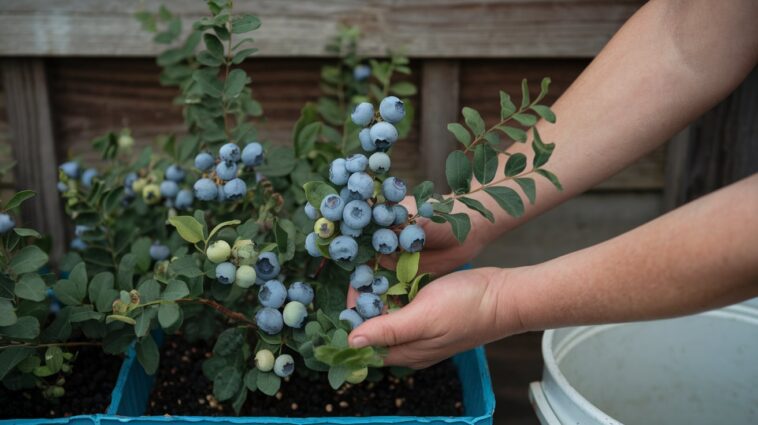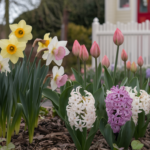There’s something incredibly rewarding about stepping onto my patio and picking fresh, juicy blueberries straight from my own plants. Growing blueberries in containers has been one of my most enjoyable gardening experiences, especially since I have limited yard space.
Not only do these little berries pack a flavorful punch, but they’re also rich in antioxidants and easy to maintain when given the right care. If you’re thinking about growing blueberries in pots, I’ll walk you through everything I’ve learned—from choosing the right container to ensuring a bountiful harvest.
Choosing the Right Container

Selecting the right container is crucial for the health of your blueberry plants. I use large, durable pots that are at least 18 inches in diameter and 18 inches deep. Blueberries have shallow but spreading roots, so they need enough room to grow while still providing excellent drainage. I prefer containers made of ceramic or food-grade plastic, as they retain moisture well without overheating in the summer. Make sure your pot has drainage holes to prevent root rot, as blueberries dislike sitting in excess water.
Selecting the Best Variety
Not all blueberries are suited for container growing, so I choose dwarf or compact varieties that thrive in limited space. Here are some of my favorites:
- Top Hat – A compact, self-pollinating variety perfect for small containers.
- Sunshine Blue – Produces delicious berries and has beautiful pink flowers.
- Jelly Bean – A small but productive variety with extra-sweet fruit.
- Northblue – A cold-hardy type that does well in northern climates.
- Peach Sorbet – Offers year-round colorful foliage and tasty berries.
- Pink Lemonade – A unique variety with pink, sweet berries.
- Tophat – A tiny but mighty plant that’s excellent for patio containers.
- Patriot – Known for its large, flavorful fruit and adaptability to different climates.
- Bluecrop – A high-yielding, disease-resistant option.
- Legacy – Produces berries with an excellent balance of sweetness and tartness.
- Biloxi – Ideal for warmer regions with mild winters.
- Misty – A heat-tolerant, early-ripening variety.
- Duke – Produces an abundant early-season harvest.
- Bountiful Blue – A highly productive and ornamental choice.
- Chandler – Grows some of the largest blueberries I’ve ever seen!
Planting Process
The key to growing healthy blueberry plants is acidic soil with a pH between 4.5 and 5.5. I use a high-quality, well-draining potting mix designed for acid-loving plants or mix my own with peat moss, pine bark, and perlite. When planting, I gently loosen the roots before placing the plant in the pot, ensuring the root ball sits just below the soil line. After filling the container with soil, I water thoroughly to settle everything in place.
To further ensure proper acidity levels, I occasionally add sulfur or an acidic fertilizer to the soil. It’s also important to refresh the soil every couple of years to maintain its health and nutrient content.
Care and Maintenance
Watering: Blueberries need consistent moisture, but they don’t like soggy soil. I water my plants deeply every few days, especially during hot summer months, making sure the top inch of soil never dries out completely. Using mulch like pine needles or shredded bark helps retain moisture and keeps the soil cool.
Fertilizing: Since blueberries prefer acidic conditions, I use an organic fertilizer formulated for acid-loving plants, applying it in early spring and again after fruiting. Coffee grounds and pine needles can also help maintain soil acidity. I avoid using too much nitrogen-rich fertilizer, as it encourages leafy growth at the expense of fruit production.
Pruning: Each winter, I trim back dead or weak branches to encourage healthy growth. Removing excess stems improves airflow and allows sunlight to reach all parts of the plant, leading to better fruit production. Pruning also helps keep the plant’s shape compact and manageable.
Pest and Disease Management: Blueberries are generally hardy, but I keep an eye out for aphids, spider mites, and birds. I use insecticidal soap for pests and netting to protect ripening fruit from hungry birds. Additionally, I watch for fungal diseases like powdery mildew and treat affected plants with organic fungicides when necessary.
Winter Protection
If you live in a colder climate, protecting your blueberry plants during winter is essential. Since container plants are more susceptible to freezing temperatures, I insulate my pots by wrapping them in burlap or moving them to a sheltered location like an unheated garage. Adding a thick layer of mulch around the base of the plant also helps protect the roots from extreme cold.
Harvesting
The best part of growing blueberries is harvesting! Berries are ready when they turn a deep blue and easily detach from the stem. I usually pick them in the morning when they’re cool and firm, enjoying some fresh while freezing the rest for smoothies and baking. The more I pick, the more the plant produces, so I make sure to check for ripe berries every few days during the growing season.
To extend the harvest season, I grow multiple varieties that ripen at different times. Early, mid, and late-season blueberries ensure a steady supply of fruit for months.
Final Thoughts
Growing blueberries in containers has been a game-changer for me. Not only do I get to enjoy fresh, homegrown fruit, but I also love the aesthetic appeal of blueberry plants on my patio. They’re low-maintenance, space-efficient, and rewarding in so many ways. If you’re thinking about giving it a try, I highly recommend it—there’s nothing quite like the taste of homegrown blueberries straight from the bush! Plus, with the right care and attention, your blueberry plants can thrive for years, providing you with delicious fruit season after season.


